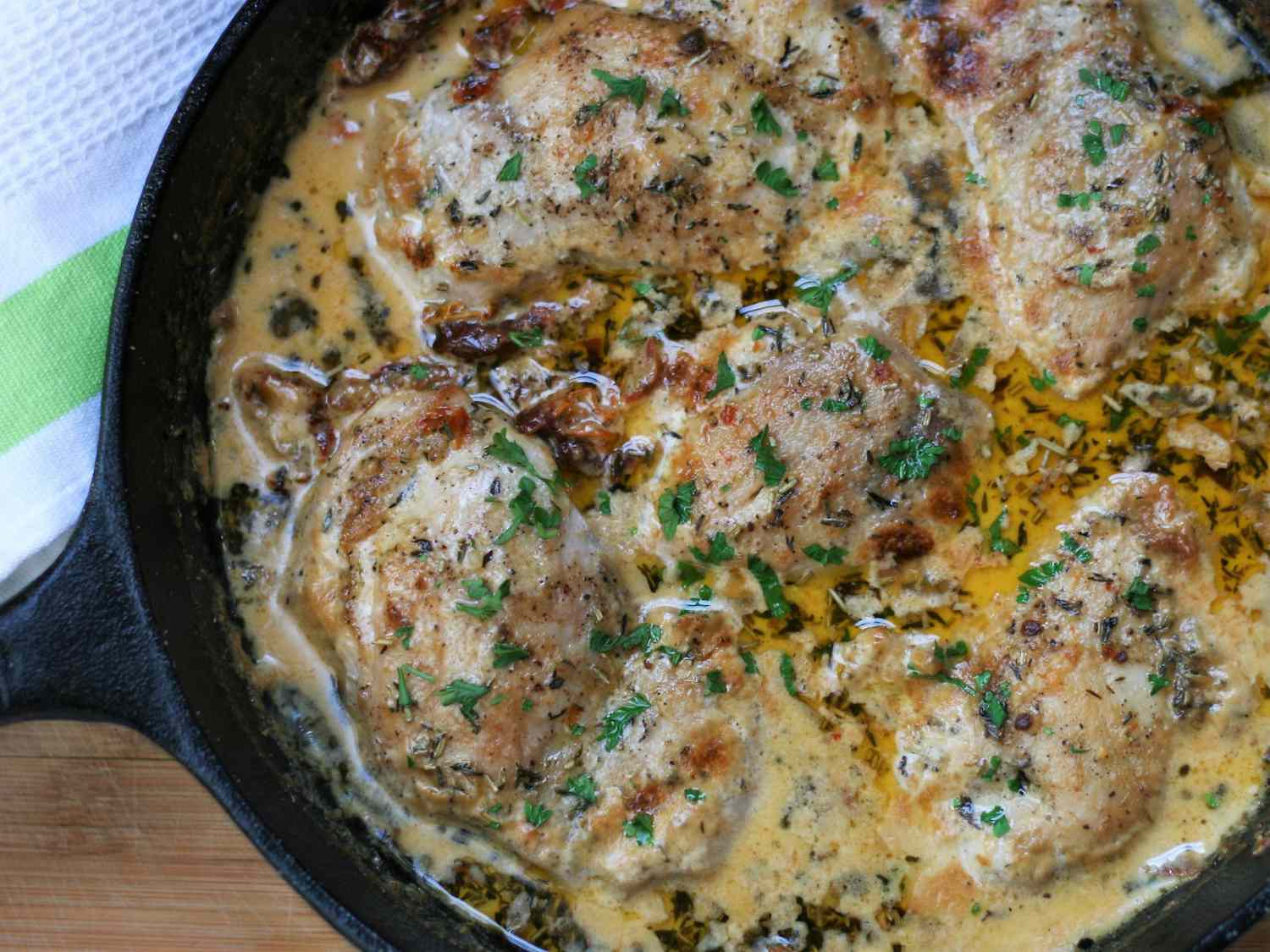Perfect Chicken Thighs in Cast Iron Skillet :
Chicken thighs are an incredibly versatile and flavorful cut of meat. Whether you’re a beginner cook or an experienced chef, using a cast iron skillet can elevate your chicken thighs to new heights. This article will guide you through the process of cooking chicken thighs in a cast iron skillet, from preparation to cooking techniques, seasoning ideas, and how to achieve a perfectly crispy skin. Plus, we’ll provide internal and external resources to help you master this delicious dish.

Why Cook Chicken Thighs in a Cast Iron Skillet?
Cast iron skillets are beloved by chefs and home cooks alike for their ability to distribute heat evenly and maintain a steady temperature. When cooking chicken thighs, especially with the skin on, a cast iron skillet provides the ideal environment for achieving a perfectly crispy exterior and juicy interior. The skillet’s ability to retain heat ensures that the chicken cooks evenly, and its high heat retention helps create a beautiful sear on the skin.
In addition, cast iron skillets are incredibly durable, making them ideal for high-heat cooking and oven-baking, which are common methods for cooking chicken thighs.
What You’ll Need
Before diving into the recipe, here’s a list of the tools and ingredients you’ll need to prepare chicken thighs in a cast iron skillet:
Ingredients:
- 4 bone-in, skin-on chicken thighs (you can use boneless if preferred, but bone-in is recommended for juicier results)
- Salt and pepper (to taste)
- 1-2 tablespoons of olive oil or vegetable oil
- Fresh herbs (such as rosemary, thyme, or sage)
- 2 cloves garlic, minced (optional)
- 1 tablespoon butter (optional, for added richness)
Tools:
- Cast iron skillet
- Tongs
- Meat thermometer (to ensure the chicken reaches the perfect internal temperature)
Step-by-Step Guide to Cooking Chicken Thighs in Cast Iron
Now that you have all your ingredients and tools ready, let’s dive into the process of cooking chicken thighs in your cast iron skillet.
Step 1: Preparing the Chicken Thighs
Start by patting the chicken thighs dry with paper towels. This will help the skin crisp up during cooking. After drying, season the chicken thighs generously with salt and pepper. You can also add other spices like paprika, garlic powder, or onion powder for extra flavor. If you’re using fresh herbs, you can add them at this point as well.
For an added touch of flavor, try marinating the chicken thighs for a few hours or overnight. This helps infuse the meat with rich seasoning and makes it even more flavorful.
Step 2: Heating the Cast Iron Skillet
Place your cast iron skillet on the stove over medium-high heat. Let it heat up for 5-7 minutes. A properly heated cast iron skillet is crucial for achieving that perfect sear on the chicken skin. You can test the heat by adding a drop of water to the skillet; if it sizzles and evaporates immediately, the skillet is ready.
Add 1-2 tablespoons of oil to the skillet and let it heat up. Olive oil or vegetable oil works best, but you can also use other oils with a high smoke point like canola or avocado oil.
Step 3: Searing the Chicken Thighs
Once the skillet is hot and the oil is shimmering, carefully place the chicken thighs, skin-side down, into the skillet. Use tongs to gently lay them in to avoid splattering hot oil. Do not overcrowd the skillet; if necessary, cook the chicken in batches.
Sear the chicken for about 7-10 minutes without moving it. This will allow the skin to become crispy and golden brown. Avoid pressing down on the chicken with your spatula, as this will release moisture and make the skin soggy.
Step 4: Flipping the Chicken
Once the skin is golden brown and crispy, use tongs to flip the chicken thighs over. At this point, you can add fresh herbs and garlic for extra flavor. If you prefer, you can also add a tablespoon of butter at this stage for richness.
Reduce the heat to medium-low and let the chicken thighs cook for another 10-15 minutes, depending on the size of the thighs. The chicken is done when it reaches an internal temperature of 165°F (75°C). Use a meat thermometer to check the temperature in the thickest part of the thigh, avoiding the bone.
Step 5: Resting and Serving
Once the chicken thighs are cooked through, remove them from the skillet and let them rest for 5-10 minutes. This allows the juices to redistribute and keeps the meat tender and juicy.
Serve your crispy cast iron skillet chicken thighs with a side of roasted vegetables, mashed potatoes, or a fresh salad. Enjoy the flavorful and crispy skin with every bite!
Tips for Perfect Cast Iron Skillet Chicken Thighs
- Pat the chicken dry: Moisture on the skin can prevent it from becoming crispy. Patting it dry with paper towels ensures the skin crisps up beautifully.
- Use a meat thermometer: This ensures your chicken is perfectly cooked and reaches a safe internal temperature.
- Don’t overcrowd the skillet: Cooking too many pieces at once can cause the chicken to steam instead of sear. If needed, cook in batches.
- Let the chicken rest: Resting the chicken for a few minutes after cooking ensures the juices redistribute, keeping the meat tender and juicy.
- Flavor variations: Experiment with different seasonings, such as Cajun spices, lemon zest, or smoked paprika, to give the chicken a unique twist.
Health Benefits of Chicken Thighs
Chicken thighs are not only flavorful but also nutritious. They are an excellent source of protein and essential vitamins and minerals, such as B vitamins, iron, and zinc. Compared to chicken breasts, thighs contain more fat, which contributes to their rich, juicy flavor. If you’re concerned about the fat content, you can remove the skin after cooking to reduce the fat content.
Additionally, using a cast iron skillet for cooking chicken thighs helps maintain the meat’s nutrients. Cooking with cast iron is often considered healthier because it adds trace amounts of iron to your food.
External Resources for Expert Tips and Techniques
For more tips and techniques on cooking with cast iron, here are some valuable resources you can explore:
Internal Linking to Recipesify
For more delicious chicken recipes, be sure to check out some of our favorites on Recipesify:
Conclusion
Cooking chicken thighs in a cast iron skillet is an excellent way to achieve a crispy, flavorful exterior while maintaining a juicy, tender interior. By following these easy steps and tips, you can enjoy perfectly cooked chicken every time. Don’t be afraid to experiment with different seasonings and flavors to make this dish your own. Whether you’re a beginner or an expert in the kitchen, this method will help you make the most out of your chicken thighs.

